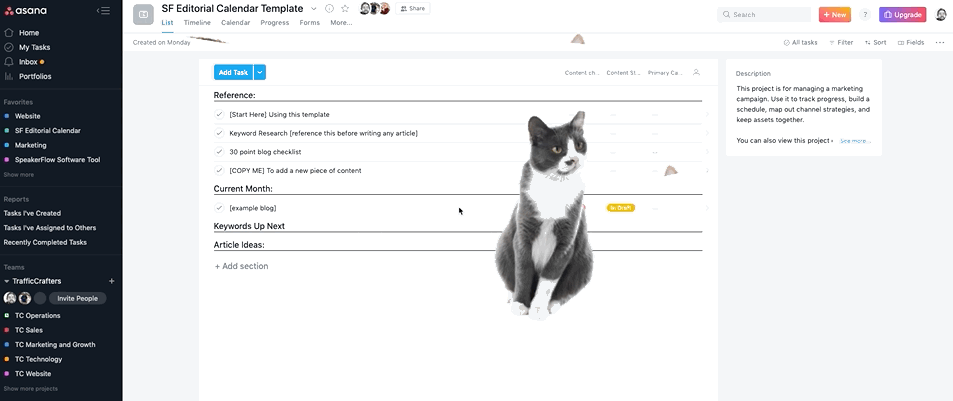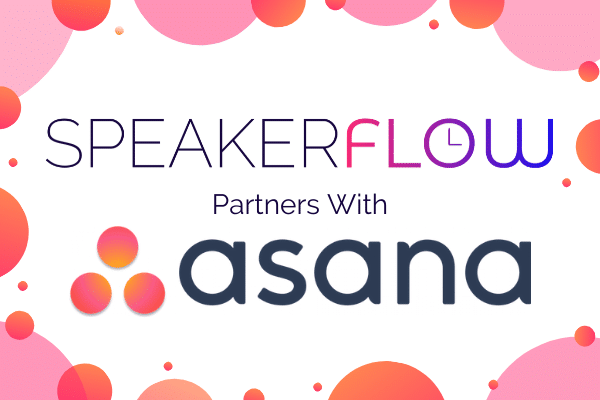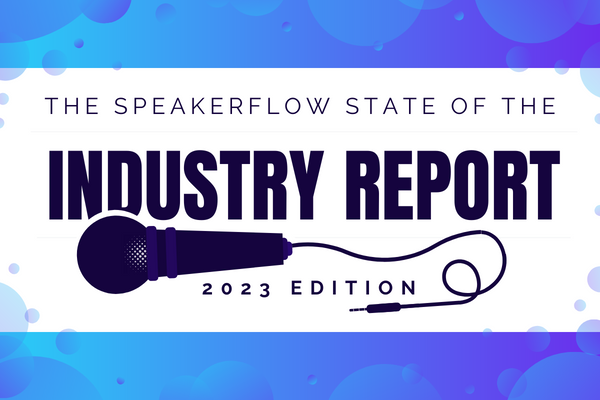If you’re an avid reader of the SpeakerFlow blog, you’ve probably noticed our many partners. Many of these partners are companies for tools and systems that we’ve found to be useful, in our experience. Some examples include HubSpot and their business systems as well as Sam Richter and his expertise in building the Speaker Intel Engine.
One partner we didn’t have was a project manager, which seems silly for a number of reasons. First and foremost, we love using a project manager. In fact, we outlined a “getting started” guide to project management systems for speakers back when we started SpeakerFlow. The second reason is simply that we use one every day and the benefits have been unquantifiable as we’ve grown. To put it dramatically, we could not operate without our project management system. We even used it to organize our content writers for all of these blogs!
So, with all of this in mind, we finally partnered with a project manager. Unsurprisingly, it happens to be our tried and true favorite: Asana. In the aforementioned project management guide, we briefly discussed Asana and a few of the features we love about it. Here, we’ll go into a little more detail about Asana, as a system and a company, and why we keep coming back to them for our own use.
A Brief History of Asana
Asana was created back in 2008 by Facebook co-creator Dustin Moskovitz and software developer Justin Rosenstein. Both entreprenuers met through their work on Facebook and decided to launch Asana for their own use first. Ultimately, their goal was to make team work effortless and streamlined. In their words, “At Asana, we’re building a place where everything from the most immediate details to the big picture are organized. With Asana, each person knows what they should be doing and why. This clarity, transparency, and focus allows teams to collaborate with less friction and produce great results.”
As the company grew, they remained dedicated to both business efficiency and the value they saw in their team. To this day, their core belief is “We believe coordination should be as effortless between people as it is between our own brains and bodies, that people should be appreciated, and love what they do.” As one of the co-founders of SpeakerFlow, I can say with 100% certainty it was with this goal in mind that we created SpeakerFlow, too.
Today, Asana boasts a team of hundreds and an approval rating of 4.8 out of 5 on Glassdoor. To us, this meant not only a company that provides quality services and products. It also showed a company that put their money where their mouth was and didn’t lose sight of their original values. Here at SpeakerFlow, our goal is to bring that same attitude to both our team members and our clients. So, naturally, we loved Asana from Day 1. 👌
Top Five Features of Asana
Besides their company culture, there are a ton of technological things to love about Asana, too. From their continued updates to the usability, Asana as a whole gives you a ton of bang for your buck. This is true regardless of the plan you’re on, and even the free plan is remarkably robust. Below, let’s break down a few of the features we at SpeakerFlow can’t live without.
1. Multiple layouts let you organize each project uniquely.
Every project is a little different, so each one might need some tweaking to make sure it’s organized, right? Asana makes that easy with multiple different ways to view a given project as you organize it. These layouts include standard designs such as a calendar view to see when upcoming tasks are due and a list view, so you can segment the project into different parts. There’s also a board view for projects with multiple moving parts that move through a set process. This view can be great if you have a proven process for organizing travel for your speaking gigs, for example. It’s also great if you have multiple team members working on a project and you want to see, as the head of your speaking business, how each part of the project is coming along.
Besides the general layout, each view can be further customized with custom fields and drop down menus. This allows you to make each project super specific to your speaking business and its needs. It also allows you to track metrics for each part of the project. That way, you stay on track and, if you don’t you can see when and where you went wrong.
2. Their collection of pre-formatted templates is amazing.
On top of different overall layouts, Asana also comes with a collection of over 50 templates to get you started. These templates are great if you are new to Asana and want to see more of the detailed features. Additionally, if you’ve never used a project management system at all, the template collection is an awesome resource. Besides saving time, it’s helpful if you’re unsure which parts of your speaking business should be tracked in a project manager in the first place.

Some of my personal favorite templates include the editorial calendar, the marketing campaign plan, and the company goals and objectives. As a startup, we’ve used each of these, in some capacity, to make sure we hit all of our goals and kept growing, even under the weight of many tasks. For the majority of speakers out there, I don’t have to explain how this feels. That said, in the lens of a speaking business, there are a few other templates in the collection that could be helpful, right out of the gate. These include the new employee onboarding and event planning templates, the former for hiring a virtual assistant and the latter for planning your travel to ongoing gigs.
All of these templates are available for free online and can be used repeatedly. You can also edit each template after choosing it, so it fits in perfectly with your existing workflow and terminology. That’s just another reason we love Asana: You can easily make it work for you instead of trying to conform to its system.
3. Recurring tasks save time and give you peace of mind.
Moving on, within the Asana system, there are a ton of useful features that aren’t as eye-catching as the templates. Not least among these is the “recurring tasks” feature. This lets you set tasks to repeat after a given period of time (surprise surprise). Besides saving a ton of time and manual entry for reminders you need regularly, it also gives you peace of mind.
Looking at social accounts, for example, there are a ton of things to keep on top of, as a speaker. On top of posting regularly to Facebook, Twitter, and LinkedIn, you also want to be commenting on posts from other speakers and event planners and interacting with your followers and fans. By setting each of these tasks as due today and repeating tomorrow, you can get them done for now and not have to worry that you’ll forget later on in the week. Asana has your back there. 👍
4. You can integrate it with your other systems and tools.
Another plus to using Asana and one we tend to value highly here at SpeakerFlow is integrations. With over 100 additional apps in its directory, each Asana account can be connected to many of the systems you’re probably already using right now. Some of my personal favorites are Slack for communicating with our team and Google Drive for organizing our company files.
Additionally, Asana connects with a variety of other systems, such as a customer relationship manager. Although their native CRM integrations are limited to Pipedrive, Zoho, and Hubspot, they also connect to Zapier. That way, regardless of the CRM you use, you can connect it to your Asana account with ease.
5. The whole system is interactive, making tedious tasks fun.
Last but not least, Asana is just fun – plain and simple. Besides having a bright and colorful brand, there are also a handful of animations and graphics built into the platform to make it interactive. Some of the more common ones include a narwhal or a unicorn as well as a yeti (which I am still trying to get).
My personal favorite, as a lover of both cats and silliness, is the TAB + B function, which populates your Asana board with tabby cats. If you’re not afraid of cats, what’s not to love about that? 🙌

Asana Pricing
Finally, one of the reasons we started with Asana and, now that we’re in business, we’ve stuck with Asana is the pricing. Hands down, in comparing other project management systems, Asana was one of the few that gave you undeniably useful features free of charge. Among others, these include a variety of project views, collaborate with up to 15 teammates, and integration with over half of the apps in their directory.
Besides the free plan, their paid plans are easily affordable, so your Asana account can grow with your business. Starting at $13.49 per user per month, the first tier plan has the majority of features the average speaking business needs for a more than reasonable price point. I can also promise, based on my own experience, that using a project manager (even if you don’t choose Asana) will be well worth the money.
Ultimately, if you love Asana but don’t know how to get started or if you already have an Asana account, but want to maximize it, we’re here for you! Part of our reason for partnering with Asana was to become certified pros at using it, so we could pass that knowledge on to you. Our own master of operations, Austin Grammon, is here to get your project management wheels in motion, whenever you’re ready.
On the other hand, if you’re not sure Asana’s the right fit for you, that’s a-okay, too! Feel free to drop us a line and we’re happy to show you around, so you can get a feel of what’s the best system for your speaking business. 👍





